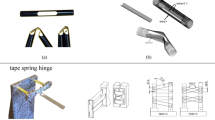Abstract
Flexible tape-spring hinges can be folded elastically and are able to self-deploy by releasing stored strain energy with fewer component parts and slight weights. This study presents a detailed investigation of the folding and deployment of single-layer tape-spring (SLTS) hinges and double-layer tape-spring (DLTS) hinges under pure bend loading. The material properties of tape-spring hinges are measured using an INSTRON machine. A DLTS hinge construction is created, and its moment-rotation relationship during quasi-static deployment is measured. An experiment is conducted to verify the validation of the numerical models for the DLTS hinges. The quasi-static deployment behavior of SLTS hinges and DLTS hinges is then analyzed using nonlinear finite element ABAQUS/Explicit solver, starting from the complete folded configuration. The DLTS hinge has good quasi-static deployment performances with regard to maximum stress (S m ), steady moment (M *) and the peak moment (M d ) during the DLTS hinge quasi-static deployment. In addition, the sampling designs of the DLTS hinges are created based on a three-level full factorial design of experiments (DOE) method. The surrogate models of S m , M * and M d of the DLTS hinges are derived using response surface method (RSM) to reduce the computational cost of quasi-static folding and deployment of numerical simulations. The Multiobjective optimization design (MOD) of the DLTS hinge is performed using modified non-dominated sorting genetic algorithm (NSGA-II) algorithm to achieve the optimal design. The finite element models for the optimal design based on numerical method are established to validate the optimization results.













Similar content being viewed by others
References
Block J, Straubel M, Wiedemann M (2011) Ultralight deployable booms for solar sails and other large gossamer structures in space. Acta Astronaut 68(7–8):984–992
Boesch C, Pereira C, John R, Schmidt T, Seifart K, Sparr H, Lautier JM, Pyttel T (2008) Ultra light self-motorized mechanism for deployment of light weight space craft appendages. 39th aerospace mechanisms symposium7–9 May 2008, Newport, NASA Marshall Space Flight Center
Box GEP, Wilson KB (1951) On the experimental attainment of optimum conditions. J Roy Stat Soc 13:1–45
Deb K, Pratap A, Agarwal S, Meyarivan T (2002) A fast and elitist multiobjective genetic algorithm: NSGA-II. IEEE Trans Evol Comput 6(2):182–197
Hou SJ, Dong D, Ren LL, Han X (2012) Multivariable crashworthiness optimization of vechicle body by unreplicated saturated factorial design. Struct Multidiscip Optim 46:891–905
Hou SJ, Liu TY, Dong D, Han X (2014) Factor screening and multivariable crashworthiness optimization for vechicle side impact by factorial design. Struct Multidiscip Optim 49:147–167
Li M, Deng ZQ, Liu RQ, Guo HW (2011) Crashworthiness design optimization of metal honeycomb energy absorber used in lunar lander. Int J Crashworthines 16(4):411–419
Lindman HR (1992) Analysis of variance in experimental design. Springer, New York
Liu YH, Day ML (2008) Bending collapse of thin-walled circular tubes and computational application. Thin-Walled Struct 46(4):442–450
Mallikarachchi HMYC, Pellegrino S (2010) Optimized designs of composite booms with integral tape-spring hinges. 51st AIAA/ASME/ASCE/AHS/ASC structures, structural dynamics, and materials conference12–15 April 2010, Orlando, Florida
Mallikarachchi HMYC, Pellegrino S (2011) Quasi-static folding and deployment of ultrathin composite tape-spring hinges. J Spacecr Rocket 48(1):187–198
Mansfield EH (1973) Large-deflexion torsion and flexure of initially curved strips. Proc R Soc Lond A Math 334(1598):279–298
Marks GW, Reilly MT, Huff RL (2002) The lightweight deployable antenna for the MARSIS experiment on the mars express spacecraft. 36th aerospace mechanisms symposium 14–17 May 2002. Cleveland, Ohio
Mobrem M, Adams DS (2009) Deployment analysis of lenticular jointed antennas onboard the mars express spacecraft. J Spacecr Rocket 46(2):394–402
Oya K, Onoda J (2002) Characteristics of carpenter tape hinge made of TiNi alloy. 43rd AIAA/ASME/ASCE/AHS/ASC structures, structural dynamics, and materials conference22−25 April 2002, Denver, Colorado
Qi C, Yang S, Dong FL (2012) Crushing analysis and multiobjective crashworthiness optimization of tapered square tubes under oblique impact loading. Thin-Walled Struct 59:103–119
Seffen KA (2001) On the behavior of folded tape-springs. J Appl Mech T ASME 68(3):369–375
Seffen KA, Pellegrino S (1999) Deployment dynamics of tape springs. Proc R Soc Lond A 455:1003–1048
Seffen KA, You Z, Pellegrino S (2000) Folding and deployment of curved tape springs. Int J Mech Sci 42:2055–2073
Silver MJ, Hinkle JD, Peterson LD (2004) Modeling of snap-back bending response of doubly slit cylindrical shells. 45th AIAA/ASME/ASCE/AHS/ASC structures, structural dynamics, and materials conference 19–22 April 2004. Palm Springs, Calif
Silver M, Hinkle JD, Peterson LD (2005) Controlled displacement snap-through of tape springs: modeling and experiment. 46th AIAA/ASME/ASCE/AHS/ASC structures, structural dynamics & materials conference18–21 April 2005, Austin, Texas
Soykasap O, Pellegrino S, Howard P, Notter M (2008) Folding large antenna tape spring. J Spacecr Rocket 45(3):560–567
Watt AM, Pellegrino S (2002) Tape-spring rolling hinges. 36th aerospace mechanisms symposium15–17 May 2002, Cleveland, OH
Yang H, Deng ZQ, Liu RQ, Wang Y, Guo HW (2014) Optimizing the quasi-static folding and deploying of thin-walled tube flexure hinges with double slots. Chin J Mech Eng 27(2):279–286
Yee JCH (2006) Thin CFRP Composite Deployable Structures, PhD thesis, University of Cambridge
Yee JCH, Pellegrino S (2005) Composite tube hinges. J Aerosp Eng 18:224–231
Acknowledgments
This project is supported by the College Discipline Innovation Wisdom Plan in China (Grant No. B07018), the Self-Planned Task (No.SKLRS201401A02) of State Key Laboratory of Robotics and System (HIT), and the Fundemental Research Funds for the Central Universities (No.HIT.NSRIF.2015050). This support is gratefully acknowledged by the authors.
Author information
Authors and Affiliations
Corresponding author
Rights and permissions
About this article
Cite this article
Yang, H., Liu, R., Wang, Y. et al. Experiment and multiobjective optimization design of tape-spring hinges. Struct Multidisc Optim 51, 1373–1384 (2015). https://doi.org/10.1007/s00158-014-1205-9
Received:
Revised:
Accepted:
Published:
Issue Date:
DOI: https://doi.org/10.1007/s00158-014-1205-9




